Article and all photos by Joe Mock, BaseballParks.com
All rights reserved
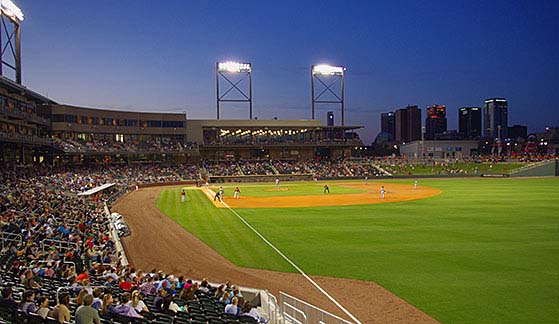 |
You’ve heard this story many times. A baseball team wants a new ballpark, and its owners tell this to their current city. Often, the threat of moving to a suburb or to an entirely different market is part of the dialog. The team ends up with a new ballpark, and it might be in its current city, or in a nearby community or in another part of the country.
| Ballpark Stats |
 |
| Award: Baseballparks.com’s Ballpark Of The Year for 2013 (press release) |
| Team: Birmingham Barons of the Double-A Southern League |
| First regular-season game: April 10, 2013, a 9-5 win over the Mississippi Braves |
| Capacity: 8,500 (6,250 fixed seats plus 2,250 general admission and group areas) |
| Architect: HKS, assisted by local firm Hoskins Architecture |
| Construction: Joint venture of Robins & Morton and A.G. Gaston |
| Price: The cost of constructing the ballpark itself was $42 million. Total cost of project including land acquisition and site prep was $64 million. |
| Home dugout: 1B side |
| Field points: East |
| Playing surface: Tifway 419 grass |
| Betcha didn’t know: The base of the backstop is brick, with no padding. |
We’ve seen this played out over and over again.
How often have you heard that a franchise is offered a new ballpark in its own market, even though the team’s owners hadn’t expressed an interest in leaving their current facility?
“That’s exactly what happened here,” explained Stan Logan, one of the owners of the Birmingham Barons. The team was fairly happy in Regions Park, where it had moved in 1988. They’d left Rickwood Field (zero suites, zero club seats, not the best part of town) in Birmingham to move south to the suburb of Hoover. Regions Park did have a few drawbacks (limited space for groups, the “sterile” atmosphere that came from playing in a multi-purpose facility), but the population and commercial possibilities in Hoover were exploding, and the Barons had a good relationship with the city.
It took awhile, but the City of Birmingham decided that it missed having the Barons around. The team “began their legacy in Birmingham in 1885 and spent the past 25 years in the suburbs,” observed William A. Bell, Sr. , the Mayor of Birmingham. “It was time to bring them home.”
Of course, part of the longing to have the team return from the suburbs was due to a feasibility study that concluded that a new sports facility would have a significant economic impact. Further, depending on the location of that facility, it would trigger much-needed commercial development.
In 2010, Mayor Bell proposed that the City move forward on the sports-facility project, to be partially funded by an increase to the tax imposed on hotel rooms. At about the same time, the City was putting the finishing touches on an impressive new municipal park southwest of downtown. This proved to be an important part of the ballpark story, as you’ll see.
Railroad Park officially opened in September 2010 on a wide swath of land along active train tracks. It features bike and jogging paths, a lake, a man-made stream, impressive landscaping, playgrounds, multiple skateboarding wells and enough open space to hold several festivals or events at once. It quickly became a popular spot for families to play and groups to hold outdoor gatherings. “Railroad Park is truly one of the finest urban parks to open anywhere in the last 15 or 20 years,” noted Byron Chambers, Director of Sports Design at the architecture firm HKS. “It is a true urban asset.”
Meanwhile, the University of Alabama at Birmingham (UAB) was growing rapidly. The edge of their campus was about six blocks from Railroad Park, and the University had already acquired land in the immediate area. However, it had short-term expansion plans in some other areas on land that was owned by the City of Birmingham.
When a plan is meant to happen, things often fall into place in a relatively short period of time. The Mayor’s lodging-tax proposal was approved by the City Council, and the owners of the Barons were convinced to make their team the tenant of the stadium that would be built. A “land swap” was negotiated where the city took possession of UAB’s holdings in a four-block area adjacent to Railroad Park, and in return the University received the City-owned land that it desired for its expansion.
| Leaving the southern suburbs |
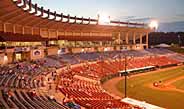 |
| In 1988, the Barons left Rickwood Field, a ballpark treasure built in 1910. They moved to the fast-growing suburb of Hoover, south of Birmingham. Hoover Metropolitan Stadium (above), dubbed “the Met,” was the team’s home through 2012. For its last six seasons, it was known as Regions Park. |
The City then had to negotiate with the business owners who had warehouses and commercial enterprises on those four blocks. According to the Mayor’s office, 17 of the 18 owners agreed to relocate, and the one who refused was at the northern tip of the four-block parcel, and the City chose to work around that business. It is quite noteworthy that the City did not resort to using “eminent domain” to force those business owners from that land. “We had that tool if we needed it,” Bell said, “but we were able to reach mutually beneficial agreements with the owners of the property needed for the ballpark.”
On February 6, 2012, demolition of the buildings on the site took place. This was just four days after a ground-breaking ceremony was held there, and over 1,000 residents attended. It was at this event where it was announced that Regions Financial, the same banking firm that owned the naming rights of the Barons’ home park in Hoover, had acquired the rights to name the new park. Hence the name Regions Field.
In order for the ballpark to open at the beginning of the 2013 season, the project had to be on the fast track. Therefore, the “design build” process was employed, where the architecture was being formulated even as construction had commenced. A joint effort of Robins & Morton and A.G. Gaston was named to do the construction, and they brought HKS on board to handle the design.
The approach worked well, and despite some unforeseen delays in the construction, Regions Field was almost completely finished when opening day arrived. The only aspects of the facility not finished in time for the opener were concession areas in center field. Otherwise, it was “Play Ball” on April 10, 2013. The Barons liked their new home so much that they swept their first series there, winning five times over the visiting Mississippi Braves.
As we take a closer look at Regions Field’s site, exterior, interior design and fan amenities, it should become obvious why it was named the Baseballparks.com Ballpark of the Year for 2013.
The Setting
It wasn’t easy for the Barons to leave the suburbs to return to the city of Birmingham. The City of Hoover and its ballpark had been great partners for the team, and the team was successful there, including a once-in-a-lifetime season (1994) when Michael Jordan played for the Barons. When the offer came to move the team north by 16 miles, the team realized that they would not only be part of the revitalization of a neighborhood in Birmingham, they would also be able to offer fans many amenities that the facility in Hoover couldn’t provide.
And, frankly, after 25 years in Hoover, it was time for a move. “The Met was built where there was nothing, but it was a good stadium for the 25 years (the Barons) were there. At some point, though, the luster comes off” of a ballpark that once seemed so new and perfect, said Solomon Crenshaw, Jr., a Hoover resident and for 32 years a writer at the Birmingham News. “The change is welcome, especially to those who live north, east and west of Birmingham.”
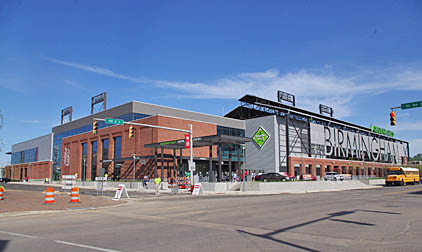 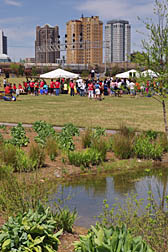 |
| On the left is the exterior of Regions Field, at the corner of 1st Avenue South and 14th Street South. On the right is a look at Railroad Park, with downtown Birmingham in the background. |
“I spent 19 years there (in Hoover),” recalled Barons GM Jonathan Nelson. “The 1994 season with Michael Jordan was really something special. We spent a lot of effort to make (the stadium) more fan-friendly, and to show the history of baseball in the area. We had a great run there, but when we did announce we were leaving, as time went by, people accepted it more and more.”
The four-block location southwest of downtown wasn’t the only one examined for a ballpark. “Other properties were considered where redevelopment was already underway,” Mayor Bell said. “None matched the potential of a site near Railroad Park. We are already realizing investment and redevelopment in the vicinity of the ballpark and are confident it will continue.”
There were a couple of businesses already operating in that neighborhood. There is an attractive, privately owned dorm for students of UAB and a brewery that also has an indoor/outdoor beer garden. Both of these are in the adjacent block on the west side of the stadium.
“This used to be a less-than-ideal area,” said Andy Henning, Associate Principal at HKS. “Now properties are being purchased all around (the stadium). It has become the epicenter for development.”
 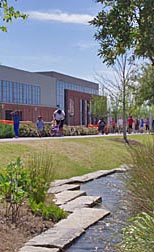  |
||
| On the left is a look at an outdoor festival taking place at Railroad Park, with Regions Field in the background. In the center is the man-made stream wandering a few feet away from the perimeter of the ballpark. Bicyclists and skateboarders enjoy Railroad Park, too. | ||
But the “neighbor” that makes Regions Field’s location perfect is Railroad Park. “The ballpark is connected to the city by the park,” HKS’ Chambers observed. “The synergy between the ballpark and Railroad Park is really nice. The stadium is activated by the people in the park all the time. Not only that, but the plan is for the ballpark to be open even when a game isn’t going on, allowing people to walk through.” This also helps achieve another goal. “UAB wanted a greenway all the way from Railroad Park to the southern end of their campus,” and the presence of the ballpark between the two provides that, according to Nelson.
The location also permits stunning views from within the park. Fans seated in the Magic City View Seats down the first-base line are treated to a spectacular view of the downtown skyline (Magic City is Birmingham’s official nickname). Those seated on the third-base side have a perfect view of the medical district’s high-rise hospitals and medical centers, as well as Red Mountain beyond.
 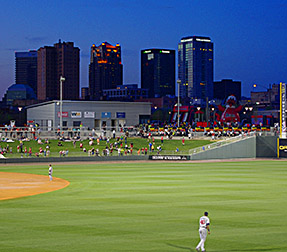 |
| The shot on the left might help orient you. It was taken from a plane, looking south. Birmingham’s downtown office buildings are in the foreground. Cutting across the middle of the photo are train tracks — the very ones that run right past Railroad Park. The ballpark is toward the upper right corner, and the medical district is in the extreme upper left-hand corner. In the extreme upper right-hand corner is part of UAB’s campus. The photo on the right is what you’ll see at twilight from the Magic City View seats. |
On the top ridge of this mountain sits one of Birmingham’s most famous landmarks. Vulcan Statue, the largest metal statue ever cast in America, represents the iron and steel industry that put the city on the map. While the statue is clearly visible during the day, at night its lights make it shine in a stunning way. It is truly beautiful when viewed from within the park.
If you visit Birmingham, I urge you to make the trek up to Vulcan Park so you can get a closer look at the 120,000-pound statue. And if you don’t mind heights, go up to the observation level so you can get a good look at Regions Field in the valley below.
  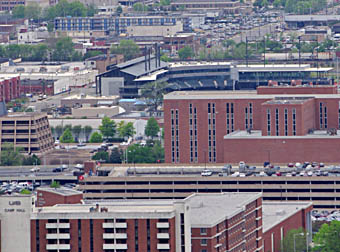 |
||
| Vulcan Statue sits atop a 123-foot pedestal at the very top of Red Mountain. At night, it shines very brightly. On the right is the view of the ballpark (using a telephoto lens) from the observation deck just below the statue itself, near the top of the pedestal. The buildings in the foreground are part of UAB’s campus. | ||
Not everything about the ballpark’s site is ideal, though. “Birmingham’s soils are unique, in that there are ‘fingers’ of stone below the surface,” Henning noted. “There was a lot of rock we didn’t expect, and that delayed construction. There were also a couple of sinkholes, and the contractor had to pour yards and yards of concrete into them before they could continue.”
This helps explain why some aspects of the park weren’t completed by Opening Day. “Of course, we were on a tight schedule even if Mother Nature had cooperated,” joked Henning.
Finally, you won’t find expansive parking lots adjacent to the new ballpark like you had in Hoover. Given the “neighborhood” nature of Regions Field, that seems to be a perfectly acceptable trade-off. You will find public lots about three blocks to the west of the park on 12th Street South and one three blocks north on 14th Street North. This last lot is also used by folks attending events at Railroad Park, and that might lessen the spaces available for baseball games. The Barons also operate four lots, all within a three or four block radius of the stadium’s perimeter.